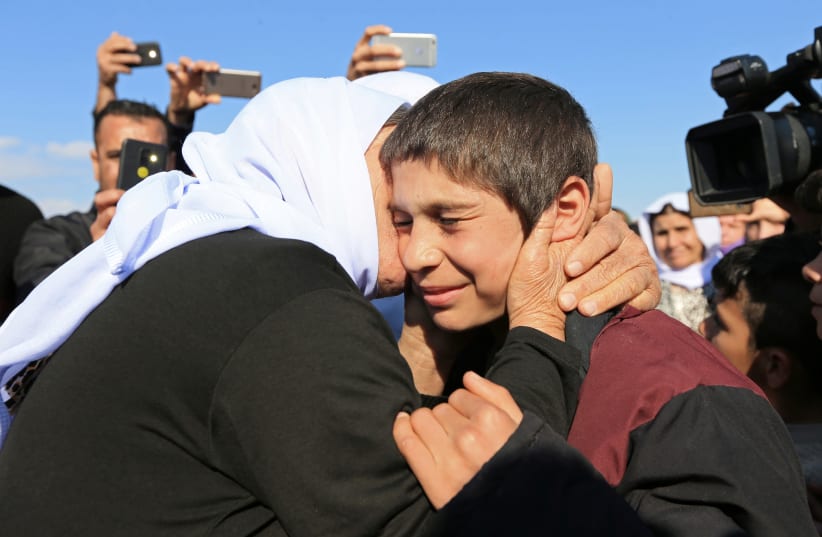Now, more than four years after the horrors began, some survivors are still being located. ISIS attacked the Sinjar region in August 2014 as part of its campaign to take over Iraq and Syria. More than 400,000 Yazidis fled the onslaught, many of them ending up in IDP camps in the Kurdistan region of northern Iraq.
Once ISIS was pushed back, more than 69 mass graves containing the bodies of Yazidi men and women were found. A total of 6,417 had been kidnapped, but several thousand were found and released through ransom or by escaping.
In the battle of Baghuz in Syria, the US-led coalition and the Syrian Democratic Forces (SDF) have pushed ISIS into a small enclave on the Euphrates River. More than 13,000 ISIS supporters have been allowed to leave the ISIS-held area and move to IDP camps. One Yazidi survivor named Bashe Hammo told the Associated Press she believed there were up to 1,000 Yazidis being held by ISIS in Baghuz. Like many Yazidis who were held as slaves, she had been sold multiple times and described being tortured by European ISIS members. One, a Swede, would lock her in the home for days without food. Other men purchased a nine-year-old girl as a slave. Many of these Europeans have now surrendered to the SDF and demand to go home, while the Yazidis face an uncertain and bleak future with little to no international support.
Eighteen Yazidi children and three women who were able to flee Baghuz were helped by the SDF to get to the Iraqi border on Saturday. However, they faced hurdles as the Iraqi government did not want to open the border. Pressure from Yazidis in Sinjar, according to locals, finally led to the border with Syria being opened.
Once they reached northern Iraq, Sheikh Naser Basha Khalaf, a community leader and politician, posted on Facebook a photo with the survivors on March 2. He described the reception and how the Yazidis had been “subjected to the worst forms of abuse and sexual assault and psychological torture.”
Dr. Nemam Ghafouri – founder and chairwoman of Joint Help for Kurdistan – said that Yazidis, even when they are free, still suffer discrimination in northern Iraq. She described how the children and women who had been rescued had to wait at the border. They were allegedly insulted by authorities, and not provided an official state reception upon returning.“Unlike ISIS and their families who in the past were given a free pass on comfortable buses,” she argued that Yazidis receive terrible transport and no support. It has led to bitterness and hopelessness among genocide survivors. They were tortured for four and a half years and she says that despite conferences paying lip service to help them, little is done on the ground.
The anti-ISIS Coalition held a meeting in Washington in which 79 members attended. Nadia Murad, the Yazidi genocide survivor, even spoke, and US Secretary of State Mike Pompeo talked about the need for justice, but it appears that words do not meet actions in northern Iraq.
Murad Ismael, leader of Yazda, which supports Yazidis, noted that the community in Sinjar has rallied to demand from the Iraqi government, the Kurdistan Regional Government and the UN to “act quickly to rescue remaining women and girls in captivity. We demand that a task force be formed promptly and reach out to security actors in Syria ASAP.” Murad says that the coalition must have a plan to help rescue Yazidis who are still missing. In the past, the coalition has indicated this is not a priority, despite the fact that US President Barack Obama ordered the intervention against ISIS after viewing events in Sinjar in August 2014.
When the 21 Yazidis had made it back to northern Iraq, one of the teens, named Salim, said that he was happy to be back with his family. “We were many [Yazidi in Baghuz], but I don’t know what has happened to others,” he said.
The SDF say that after two days of tough battles to defeat ISIS in Baghuz, that there was a pause in the offensive “due to a small number of civilians held as human shields by Daesh [ISIS].” Jane Arraf, NPR’s international correspondent who has been covering the developments, notes that there are worries for Yazidis held by ISIS and not allowed to flee Baghuz.“While ISIS’s own wives and children were sent out for safety before battle started, Yazidi intel says that ISIS told Yazidi women ‘whatever happens to us happens to you,’” Arraf's report said.
ISIS is alleged to have beheaded up to 50 people in recent weeks in Baghuz, some of whom are thought to be Yazidis. This paints a difficult picture of what has happened in Baghuz. Have 13,000 ISIS members been allowed to saunter out while victims of ISIS are held hostage? One Australian member of ISIS posed with food and smiling aid workers after leaving Baghuz.
The New Zealand Herald reported on Monday that Mark Taylor, an ISIS member from New Zealand, had told an interviewer that his biggest regret while being with ISIS for five years was not being able to “buy a slave.” Dutch ISIS member Yago Riedijk also has been doing the rounds of interviews, relaxing in a comfortable chair on video while talking about going back to Holland to live a “moderate Muslim life.”
Yazidi victims in Sinjar, meanwhile, are living in shacks and tents four years after the genocide, in worse conditions and with less infrastructure than many of the ISIS members leaving Baghuz. Video showed the 21 survivors having to drive through mud to reach their families, without even the bag of food the ISIS members were given after leaving Baghuz.
